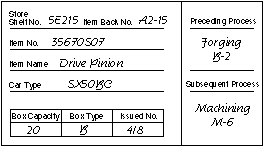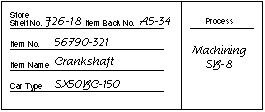Kanbans
A Kanban system is a means to achieve Just-in-time (JIT)
production. It works on the basis that each process on a production
line pulls just the number and type of components the process
requires, at just the right time. The mechanism used is a Kanban
card. This is usually a physical card but other devices can be
used. Two kinds of Kanban cards are mainly used:

A Withdrawal Kanban - specifies the kind and quantity
of product which a manufacturing process should withdraw from
a preceding process. The withdrawal Kanban illustrated (above)
shows that the preceding process which makes this part is forging,
and the person carrying this Kanban from the subsequent process
must go to position B-2 of the forging department to withdraw
drive pinions. Each box of drive pinions contains 20 units and
the shape of the box is `B'. This Kanban is the 4th of 8 issued.
The item back number is an abbreviation of the item.

A Production-ordering Kanban - specifies the kind and
quantity of product which the preceding process must produce.
The one illustrated (above) shows that the machining process
SB-8 must produce the crankshaft for the car type SX50BC-150.
The crankshaft produced should be placed at store F26-18. The
production-ordering Kanban is often called an in-process Kanban
or simply a production Kanban.
Using Kanbans on a production line
Each process (area, cell) on the production line has two Kanban
`post-boxes', one for withdrawal and one for production-ordering
Kanbans. At regular intervals a worker takes withdrawal Kanbans
that have accumulated in his process post-box, and any empty
pallets, to the location where finished parts (components, assemblies)
from the preceding process are stored. Each full pallet has attached
to it one or more production-ordering Kanbans which he removes
and puts in the appropriate post-box belonging to the process
that produced the parts. The worker now attaches a withdrawal
Kanban to the pallet and takes it back to his own process area.
When this new pallet begins to be used, its withdrawal Kanban
is put back into the withdrawal post-box. At each process on
the line, production-ordering Kanbans are periodically removed
from their post-box and used to define what parts and quantities
to produce next.
When and How Kanbans are effective
Kanbans help simplify planning and to fine-tune production
to meet changing customer demand of up to + or - 10%. The system
requires planned monthly and weekly production schedules. Kanbans
simplify day to day flexibility, and changes to the production
schedule need only to be given to the final assembly process
and will then automatically work their way back up the line.
Kanban systems can be tightened by removing cards or by reducing
the number of parts on a pallet. The effect will be to speed
the flow through the process and hence reduce lead times. However
it also makes the system more vulnerable to breakdowns and other
causes of dislocation. By identifying the areas within the line
that are causing disruption, efforts can be made to improve them.
Thus the overall efficiency of the line is raised by tackling
the key points.
Other types of Kanban Also used are Supplier Kanbans - to
withdraw goods from external suppliers, and two types of Signal
Kanban, which are inserted near the bottom of a stack of items.
These automatically initiate production of batch produced items
when the stock reaches a pre-set re-order level.
Single card Kanban systems
In a single-card Kanban system, parts are produced and bought
according to a daily schedule, and deliveries to the user are
controlled by a `conveyancing' (withdrawal) Kanban. In effect,
the single-card system is a push system for production coupled
with a pull system for delivery to the point of use. Single-card
Kanban controls deliveries very tightly, so that the using work
centre never has more than a container or two of parts and the
stock point serving the work centre is eliminated. Single-card
systems work well in companies in which it is relatively easy
to associate the required quantity and timing of component parts
with the schedule of end products. These are usually companies
with a relatively small range of end products, or products which
are not subject to rapid, unexpected changes in demand levels.
References
- Yasuhiro Monden, 1993, Toyota Production System: an integrated
approach to Just-In Time. Second edition, Industrial Engineering
and Management Press, Institute of Industrial Engineers, Norcross,
Georgia.
- Schonberger. R.J., 1982, Japanese Manufacturing Techniques:
nine hidden lessons in simplicity, Free Press, New York, London.
|